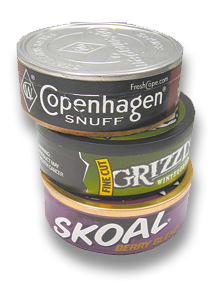- 11/12/2006
- Canton, OH
- Shane Hoover
- CantonRep.com

Michael A. White used to smoke. He chews tobacco now, and he has his reasons.
“I didn’t want lung cancer,” the 18-year-old senior said while skateboarding outside Alliance High School.
He knows chewing tobacco has its own health risks — mouth and throat cancers and “holes through your lips.” He also knows he’s addicted, but he’d rather chew than smoke, he said.
“In a way it’s because other people around you don’t get secondhand smoke and it doesn’t make you lose your breath as easy,” White said.
White’s story is not unique — to himself or to his school. While cigarettes are the most popular tobacco product, an estimated 11 percent of high school boys use chewing tobacco or moist snuff, sometimes referred to as dip, according to federal studies.
Smokeless tobacco use for adult men drops to 6 percent. It is rare among women and teenage girls.
But as laws further restrict smoking in Ohio and across the country, tobacco companies are targeting smokers in hopes that they will turn to the cigarette’s smokeless cousins. It’s a move that has anti-tobacco groups concerned.
$50 A MONTH
White started chewing five years ago. His decision to chew was based on economic, health and social concerns.
His brand of choice is Grizzly Wintergreen Long Cut. He estimated he spends about $50 a month on tobacco, but a can lasts three or four days, compared with 1 1/2 days for a pack of cigarettes. So overall, he said, it can cost half as much.
And unlike smoking, White can chew anywhere, including at school, provided he has a place to spit.
“I know it causes mouth cancer and other cancers, but it also has helped me out with my girlfriend,” White said. “My girlfriend doesn’t like cigarettes.”
The reasons young men and teens chew tobacco or use snuff vary. Kids whose family members or close friends use tobacco are more likely to use tobacco, according to the Ohio Youth Tobacco Survey.
The novelty of trying something different and the flavors added to tobacco also draw in young users, as does the macho image, said Al Stabilito, a Northeast Ohio spokesman for the American Cancer Society.
“Nicotine is in this product and they don’t quit,” Stabilito said.
ILLEGAL BUT EASY
In Ohio, it is illegal to sell tobacco to minors and illegal for them to buy or use it.
Before he turned 18, White had older friends buy it for him or bought it himself, he said.
Classmate Corey Noll, 17, agreed that tobacco products are easy to get. You just go to the right convenience store or drive-through, he said.
Noll started smoking four years ago, but he was in elementary school when he first tried chew. He found a can in a hunting vest at home. He puked.
“I swallowed it,” he said. “I didn’t know what to do.”
While he prefers cigarettes, he buys smokeless tobacco when he runs low on money, he said.
ADDICTED YOUNG
Anti-tobacco groups are worried that young people and smokers in general will start to see chewing tobacco and snuff as safer than cigarettes.
“There is no safe alternative, there is no safe tobacco,” Stabilito said.
White said he doesn’t expect to chew tobacco for a long time. His girlfriend is already starting to push him to stop. She doesn’t like the spitting, he said.
Time will tell if he can.
“I want to quit, but it’s too addicting,” White said.
Tobacco use:
The Centers for Disease Control and Prevention estimate that 44.5 million adults, or 20 percent, smoke cigarettes in the United States. By comparison, 6 percent of men use smokeless tobacco. Women are not significant users at all, studies show. A CDC survey in 2004 showed that 28 percent of high school students used tobacco. Six percent used smokeless. The rate of use by high school boys was around 11 percent.
70.3 million – Americans over the age of 12, or 29.4 percent of the population, used tobacco
59.9 million – 25 percent of the population, smoked cigarettes
13.7 million – 5.7 percent of the population, smoked cigars
7.2 million – 3 percent of the population, used smokeless tobacco
1.8 million – less than 1 percent of the population, smoked pipes
Source: 2004 survey by the National Institute on Drug Abuse

Leave A Comment
You must be logged in to post a comment.